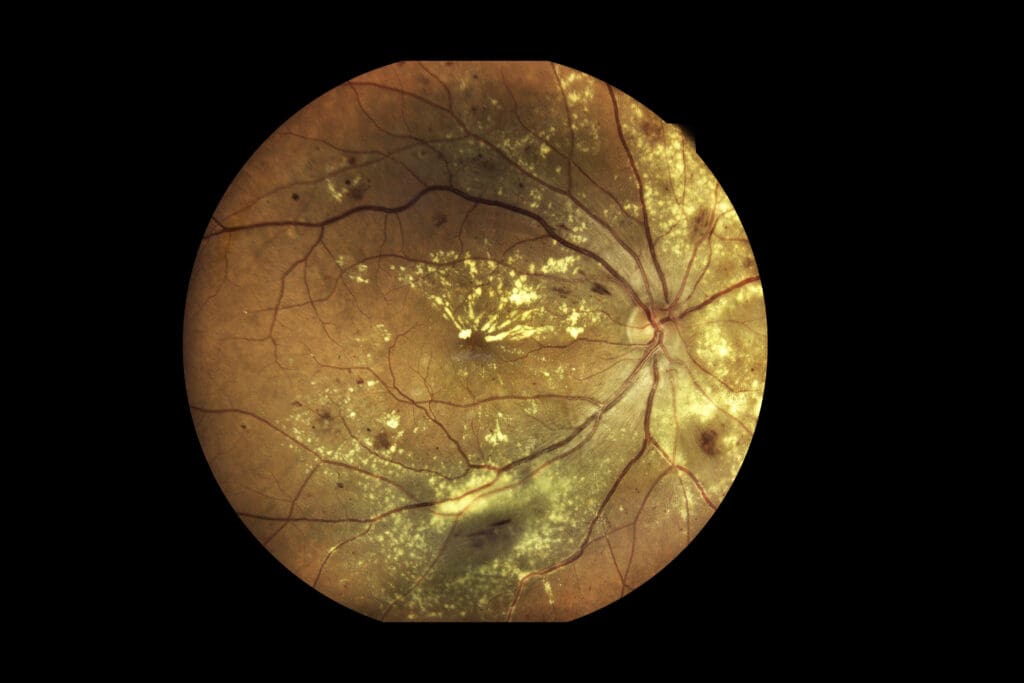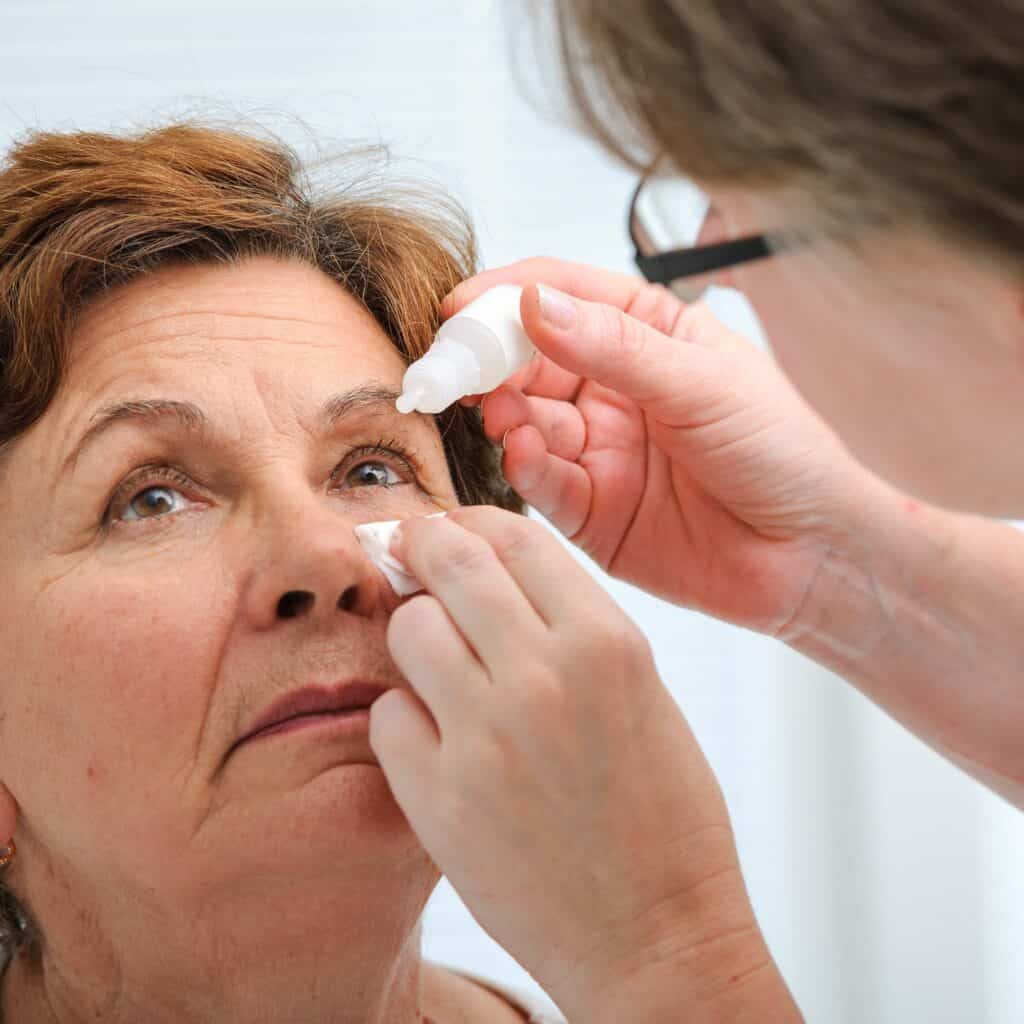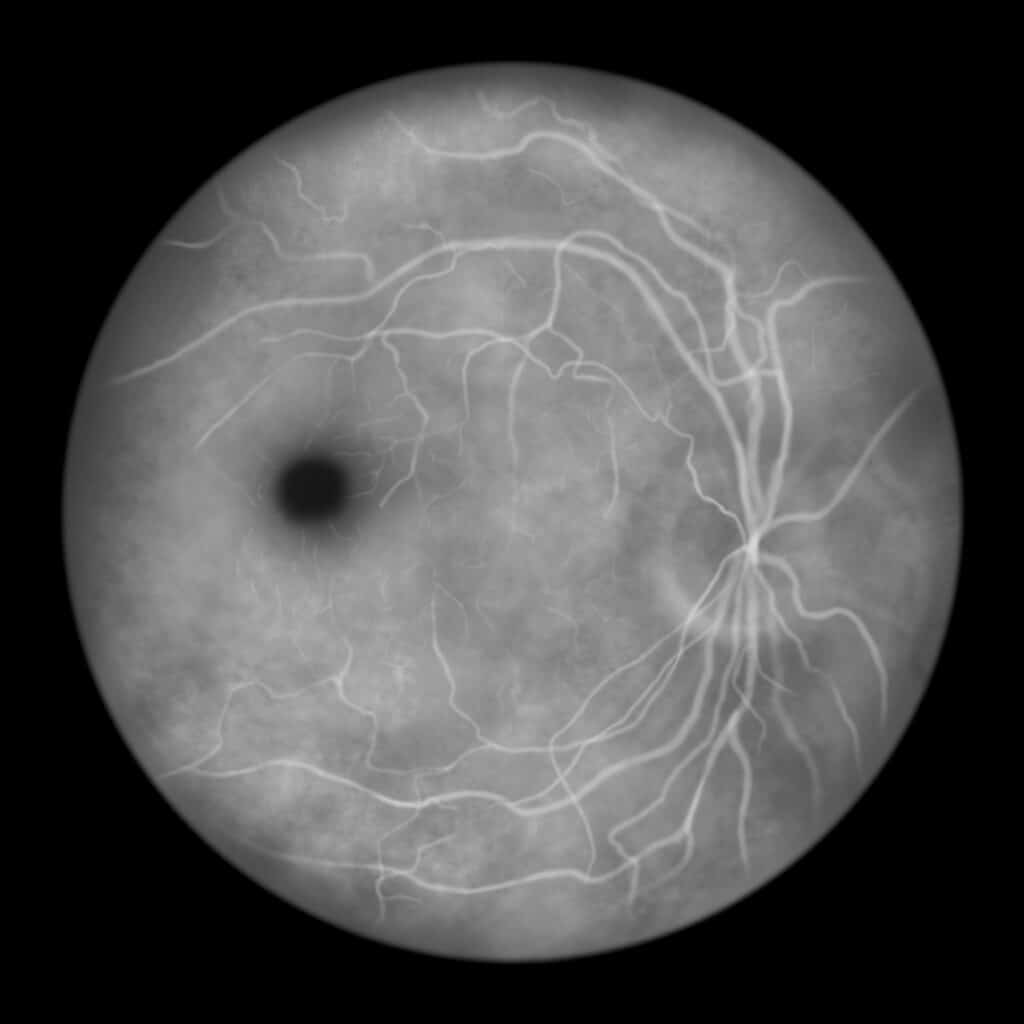Conditions
Age-related macular degeneration (AMD)
Age-related macular degeneration (AMD) is a leading cause of irreversible central vision loss in over 2 million Canadians over the age of 50.
What is age-related macular degeneration?
AMD is a breakdown of your central vision because of degeneration of cells inside the macula–the center of your retina. (Your retina is the light-sensitive part of your eye that allows you to see details by sending a visual signal to your brain via the optic nerve.)
The cells responsible for helping this visual signal travel through the retina to the optic nerve and eventually to the brain are known as photoreceptors, and they are maintained and nourished by other cells called retinal pigment epithelium (RPE).
In AMD, your photoreceptors and RPE break down or are damaged, which leads to irreversible central vision loss. Age-related macular degeneration appears in two forms: dry AMD and wet AMD. A form of advanced dry AMD is also known as geographic atrophy. Wet or neovascular AMD leads to over 90% of severe vision loss in Canadians diagnosed with this disease.
Learn about dry and wet age-related macular degeneration in more detail.


Dry AMD
Dry AMD is the most common type of age-related macular degeneration, and in advanced stages, it’s referred to as geographic atrophy (GA).
With age, the photoreceptors and retinal pigment epithelium may not work as well as they used to.
The waste–lipids, proteins, and cellular debris–produced by these photoreceptors and RPE is known as drusen or drusen bodies.
When drusens collect under the retina and start to degrade, they can damage the macula leading to atrophy or thinning of the retina.
Drusens are deposits of lipids, proteins, and cellular debris that lead to atrophy of the retina or dry age-related macular degeneration.
A percentage of people affected with dry AMD may go on to develop wet AMD.
Wet AMD
Wet AMD is less common and more severe than dry age-related macular degeneration and primarily affects the blood vessels under your macula.
As you get older, newly-formed blood vessels under the retina may not function as they should. They may break down or grow abnormally, leak blood and fluid into your eye, and cause central vision loss in the form of wet or neovascular AMD.
Read on to learn about the causes of dry and wet age-related macular degeneration.

What causes AMD?
Both forms of AMD can be caused by environmental, genetic, or nutritional factors that primarily affect people over the age of 50.
You may be at a higher risk of age-related macular degeneration if you:
- Smoke
- Have a family history of AMD
- Have blue eyes
- Have high blood pressure
- Have been diagnosed with heart disease
- Have high cholesterol
- Frequently eat foods high in saturated fat
AMD is a progressive disease, and symptoms generally get worse over time if left untreated.
Age-related macular degeneration symptoms
Age-related macular degeneration does not typically cause pain or irritation, but you may experience blurred or distorted central vision as symptoms of dry or wet AMD. Distorted central vision can be referred to as metamorphopsia. You may experience difficulty or an inability to see details in low-light conditions
The signs of dry AMD on clinical examination include the following:
- Macular pigmentary changes
- Drusen
- Geographic atrophy
The signs of wet AMD on clinical examination include the following:
- Sub-retinal fluid (fluid under the retina)
- Intraretinal fluid (fluid inside the retina)
- Retinal bleeding
- Scarring or Fibrosis (end stage)
Note that the symptoms of wet AMD can appear suddenly and progress rapidly if left untreated. It is important to be treated as soon as possible to avoid fibrosis as central visual loss is severe and permanent if the macula is scarred.
If you experience any of the symptoms above, it’s important you reach out to your ophthalmologist for an accurate diagnosis in order to treat and slow down further loss of central vision or reverse the illness’ course, which is thankfully a reality in the current era of anti-VEGF injections.



What causes AMD?
Both forms of AMD can be caused by environmental, genetic, or nutritional factors that primarily affect people over the age of 50.
You may be at a higher risk of age-related macular degeneration if you:
- Smoke
- Have a family history of AMD
- Have blue eyes
- Have high blood pressure
- Have been diagnosed with heart disease
- Have high cholesterol
- Frequently eat foods high in saturated fat
AMD is a progressive disease, and symptoms generally get worse over time if left untreated.
Age-related macular degeneration diagnosis
Age-related macular degeneration is primarily diagnosed during a regular comprehensive eye examination.
In the case of dry AMD, an ophthalmologist will look specifically for drusen–they’ll appear as small, yellowish deposits below the retina. These are readily seen with a dilated fundus exam but should be complemented by an OCT scan for proper diagnosis and follow-up.
Another important method used to differentiate between both types of AMD is fluorescein angiography (FA).
The typical workup for AMD is as follows.

Visual acuity exam
A visual acuity exam is an eye chart test used to assess your vision from various distances.
Your ophthalmologist will combine the results of the Amsler grid test and a visual acuity exam to diagnose AMD more accurately.

Dilated fundus exam
During a dilated fundus exam (DFE), your ophthalmologist will use eye drops to enlarge your pupil so they can see the fundus–the back part of the inside of your eye–more clearly and look for signs of damage to the macular.

Optical coherence tomography (OCT)
Your ophthalmologist uses a non-invasive and completely safe test using light called optical coherence tomography (OCT) to diagnose every stage of both types of age-related macular degeneration.
OCT scans can detect choroidal neovascular membranes (CNVM), which are abnormal blood vessels that sprout in wet macular degeneration (at or near the level of the RPE cells behind the macula).
These CNV are the hallmark of the wet form of AMD and can exude fluid in different ways in the macula, detectable by OCT.
OCT is also crucial in the diagnosis and follow-up of dry AMD patients.

Fluorescein angiography (FA)
Fluorescein angiography (FA) is a procedure used together with optical coherence tomography to identify the subtype of wet age-related macular degeneration diagnosed with OCT and other visual acuity tests.
During an angiography, an ophthalmologist injects sodium fluorescein molecules into your eye to highlight obstructed blood vessels or changes to retinal pigment epithelium (RPE) that may lead to a diagnosis of AMD.

Age-related macular degeneration treatment
Effective treatment for age-related macular degeneration focuses on wet AMD because there’s currently no treatment to reverse the loss of central vision that results from dry AMD.
However, there’s exciting research and new molecules for the treatment of various forms of dry AMD.
It is possible to reduce the chance of progressing from the dry to the wet form of AMD with vitamin and mineral supplements known as AREDS2.
In the case of wet age-related macular degeneration, treatment to improve your central vision and slow further damage to the macular include VEGFs inhibitors injections
Why choose Vision Pros to treat your AMD?
- Experienced ophthalmology team of specialists with expertise in all areas of ophthalmology, optometry, and general eye care.
- Rapid access and referral to world-class comprehensive screening and cutting-edge treatment in a state-of-the-art ophthalmology clinic.
- Holistic, personal, and patient-centric approach to every aspect of eye care.
Schedule your comprehensive AMD examination today
- https://www.fightingblindness.ca/eyehealth/eye-diseases/age-related-macular-degeneration/#:~:text=Age%2Drelated%20macular%20degeneration%20(AMD,dry%20AMD%20and%20wet%20AMD.
- https://iovs.arvojournals.org/article.aspx?articleid=2781783
- https://opto.ca/eye-health-library/amd-age-related-macular-degeneration
- https://pubmed.ncbi.nlm.nih.gov/18026200/
- https://www.seethepossibilities.ca/eye-health/age-related-macular-degeneration/
- https://www.medret.ca/age-related-macular-degeneration/
- https://youtu.be/XwDZBu_M3UUç
- https://youtu.be/LnAh4C6ROX8
- https://youtu.be/2r-dCGTDQRs
- https://www.ncbi.nlm.nih.gov/books/NBK559087/#:~:text=Drusen%20bodies%20are%20extracellular%20deposits,deposits%20on%20dilated%20eye%20exams
- https://www.ncbi.nlm.nih.gov/books/NBK538141/
- https://maculardegeneration.net/vision-tests
- https://maculardegeneration.net/dilated-eye-exam
- https://www.octscans.com/age-related-macular-degeneration.html
- https://amdbook.org/content/fluorescein-angiography-0